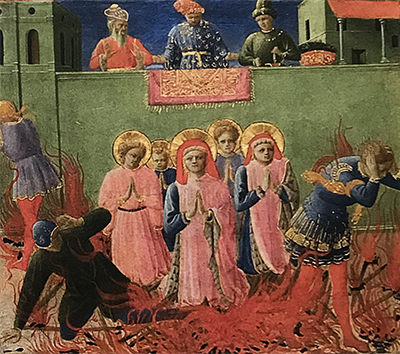Saints Cosmas and Damian Burned Alive delivers a scene that helps us to understand how these two saints achieved the status of martyr. Fra Angelico covered religious elements in all of his paintings and often would focus on the lives of those who sacrificed themselves for the better of us all.
Christianity regularly teaches its followers to remember and respect those who have fought for the rights of fellow Christians, with Jesus Christ being the most obvious example of that. One would therefore be able to reflect on their sacrifices when praying in a place of worship, with art displayed all around the walls to help remind us of this. Some would actually request smaller paintings that could be used in private residences for personal devotion, normally within one's bedroom. Fra Angelico worked to whatever requests came from his patrons but over time, as his reputation strengthened, he was more able to negotiate different elements of these projects in order to get the best artistic result possible. He would also call upon the services of his assistants who were able to complete some of the more menial tasks and free up time for the master to woo more and more patrons elsewhere in the city.
This particular fresco was known as Saints Cosmas and Damian Burned Alive and formed a part of Fra Angelico's Six Episodes from the Lives of Saints Cosmas and Damian. These items would be lined up horizontally below a main panel and each one would address an important moment in the lives of the two saints, helping us to understand more about how they achieved the status that they did. The artist produced a good number of altarpieces within his career and would normally need to visit the location many times in order to plan out the artwork and adapt it to the size of space available, as well as any intricate details of the architecture in each church or chapel.
Many other notable artists existed at around the same time as Fra Angelico, with the likes of Piero della Francesca, Giotto and Andrea Mantegna and each of these great names would add their own innovations across the various kingdoms which made up what we know today as Italy. The success of Florence would been met with envy by other regions who would then attempt to compete with their own homegrown artists in order to impress visitors with their own cultural offerings, which spread into architecture, painting, literature and also sculpture. Today we can appreciate all of these great names after considerable efforts have been made to not only preserve their artworks, but also to better understand who worked on what projects and how each region played a particular role in the overall development of Italian art.




